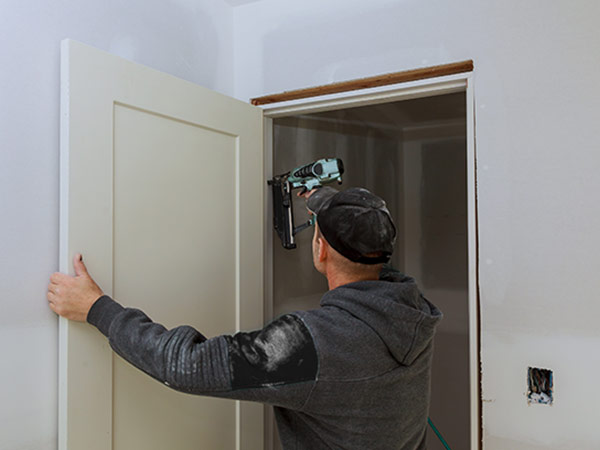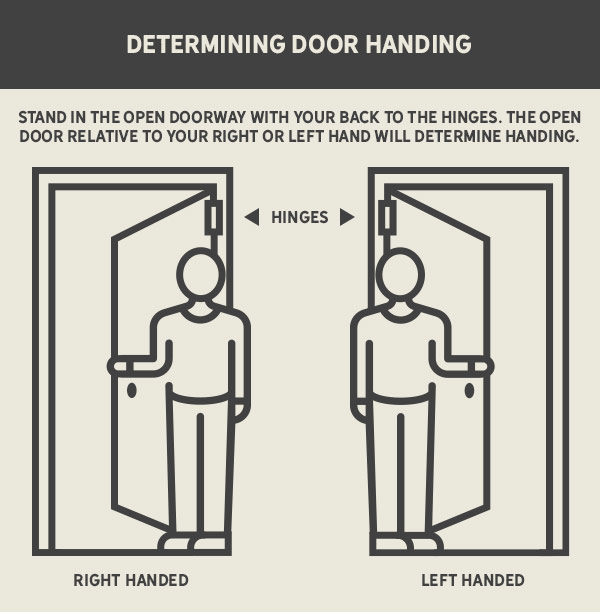

Get a Handle on How to Buy a Door
When buying a front door that matches your new home or a replacement pantry door for easier snack access, there are many options and terms that can get confusing. From pre-hung to slab, inswing to outswing, and hollow core to solid core, let us help you run through options for the best door for your space. Plus, we can assist with ordering anything from a beautiful wood entry door with sidelites to a whole house full of doors.
Exterior and Interior
Doors are divided into two different types — interior or exterior. Exterior doors, unsurprisingly, are doors that lead to the outside of your home like the front door, back patio door, or the door going into the garage. These doors need extra security, weather tightness, and some are required by code to be fire-rated (usually for a length of time) for safety. Exterior doors can also be TDI-rated or window-born debris rated for the coastal regions of Texas. Interior doors, on the other hand, are doors that never see the outside like your bedroom and bathroom doors. These two types come with their own set of options from materials to sizes.


Prehung or Slab?
Pre-hung doors come with the door installed in a frame with hinges and are ready to be installed as a unit. This option is for new homes or replacing a door unit in a remodel. Slab doors are doors without the frame and hinges that can be installed into an existing frame or hung as a barn style application. Both options don’t include doorknobs/handles/pulls, strike plate, paint or stain, fasteners, or shims. These parts are sold separately.
Note: It’s important to stain or paint the door slab on all six sides according to the manufacturer’s instructions. Leaving any side unfinished typically voids any warranty.
Sizing
When buying a door, sizes are referred to in different ways. Here are some examples:
- Looking at a door that is 36” wide and 80” high. This could be described in various ways such as 36”x80”, 3068, 3/0 6/8. 3/0 6/8 is the industry standard.
- Another example is a door measuring 32” wide and 96” high. This could be described in various ways such as 32”x96”, 2880, 2/8 8/0. 2/8 8/0 is the industry standard.
No matter how they are written, door sizes will always list the width first, then the height. Interior door sizes can range from 12” to 36” wide and 80” up to 96” tall.
When measuring for a door unit, measure the rough opening size. The rough opening is not the inside of the door frame, but the area where the complete door unit will be installed. Measure the opening height on both sides and the width at the top, middle, and bottom to calculate the minimum actual width and height of the opening. The smallest dimensions (width and height) define the usable opening. For the door frame, called a jamb, measure the thickness of the wall from the outside of wall to outside of wall. This typically will include the drywall on both sides of the wall and wood framing.
Swing

Another aspect to consider is its swing. Out or in, and where the handle will be – either right hand or left hand.
Exterior Door Swing
When discussing inswing or outswing, let’s start with exterior doors. The swing on an exterior door (front, patio, door from house to garage, etc.) is related to the interior of the house. If it swings into the house, it’s an inswing and if it swings out of the house (even into a garage) it’s an outswing. Which swing you choose will depend on space management inside your home—an inswing door going into the kitchen or utility room from the garage may not be a good use of space and an outswing into a garage would give more room to work in the kitchen or utility room.

Interior Door Swing
When choosing interior doors for your home, inswing or outswing depends more on your perspective than it does a hard-and-fast rule. In new homes, most of the time the floor plans will show which way the door will swing for installation. Choosing the door swing will depend on space management and preference. A door with glass including a front design for a pantry or a laundry room, for example, the direction the door faces will be important. When ordering the door, make sure to note if the door will swing into the pantry or out into the kitchen. If the door says “Pantry” on the glass, you definitely want it facing the correct way!
Handing
After the swing is determined, which side the handle or knob is applied will determine if it's a right-hand or left-hand door. The best way to determine this is to stand in the open doorway with your back to the hinges and facing the other side of the door frame. Whichever side the door is on relative to you tells you the "hand". For example, standing in the doorway, with your back to the hinges and the door swings left, it's a left-hand door.
Materials
Exterior Doors
- Fiberglass- A fiberglass door is made from a type of plastic reinforced with glass fibers, typically featuring two layers of fiberglass skin, an insulated foam core, and a thick polyurethane frame. These doors are popular for their durability, low maintenance, energy efficiency, and design versatility. They resist harsh weather conditions, warping, rotting, rusting, and dents, requiring minimal upkeep. Fiberglass doors offer excellent insulation and can mimic the look of wood with various styles and finishes to suit different architectural preferences.
- Steel- Steel doors have a metal skin like fiberglass and an insulated foam core. Steel doors are strong and resist warping, however they can dent. They are also easily painted.
- Wood- Most doors made of wood have an engineered wood core that provides stability. The wood on the outside is a veneer of beautiful wood like maple or oak. While wood doors are beautiful, there are pros and cons to consider. One is, for wooden doors, it’s best to have a covered entrance to help keep the elements away. Wood doors will require regular maintenance such as lacquering and staining.
- Wrought Iron- Iron doors significantly enhance a home’s curb appeal, making a bold statement and allowing for customization to match personal style. They offer superior safety due to their 16-gauge iron construction, making it difficult for intruders to break into. These doors are highly durable, as they’re galvanized and powder-coated to resist corrosion and rust, outperforming wood doors. Privacy options include clear and frosted glass to let in natural light while maintaining privacy.
- Other Types- Other exterior door options include sliding glass, French doors, and patio doors. It’s common among exterior doors to have windows called lites. A 4-lite door means the window has a grid or grille to divide the glass into four separate panes. Lites have their own u-ratings for energy efficiency and can even be low-e rated.
Interior Doors
- Solid Core Doors - These doors are prized for their robustness, sound insulation, and environmental benefits. Built with a dense, solid core, they effectively reduce noise and provide a high-end feel. They contain 70% more material than standard hollow core doors, making them sturdier, heavier, and quieter. Perfect for bedrooms, offices, or any area needing extra privacy, solid core doors offer a blend of sustainability and superior performance.
- Hollow Core Doors - Lightweight and budget-friendly, hollow core doors are ideal for interior spaces like closets and storage rooms. Although they don’t provide the same level of sound insulation as solid core doors, they are easy to handle and install, making them a practical choice for many areas of the home. They are well-suited for spaces where cost-effectiveness and functionality are important.
- Flush Doors - Featuring a completely flat, unembellished surface, flush doors are ideal for modern and minimalist interiors. They come in both hollow and solid core versions and depending on the skin, can be painted or stained to match any decor. These doors focus on simplicity, making them perfect for spaces that benefit from a clean, understated design.
- Molded Doors - Molded doors replicate the appearance of real wood at a lower cost. Available in various styles, from smooth to wood grain textures, they complement many design aesthetics. These doors are designed to be durable, resisting warping and cracking, and offer a long-lasting, versatile option for interior use.
- Flush Doors - Featuring a completely flat, unembellished surface, flush doors are ideal for modern and minimalist interiors. They come in both hollow and solid core versions and depending on the skin, can be painted or stained to match any decor. These doors focus on simplicity, making them perfect for spaces that benefit from a clean, understated design.
- Other Types- Interior doors can come in all shapes and sizes including bifold, sliding barn doors, or pocket doors. Doors can also be flush, meaning they are flat along the surface or have panels. Panels, as in a a six-panel door, can either be true panels or stamped to look like panels. True panel doors are put together using a stile and rail method where stiles are vertical boards and rails are horizontal boards that are glued together.
This is just an introduction into the world of doors. Contact your local McCoy’s where our door experts will talk swing, lites, and cores with you and help you determine the right size, material, and styles.

Reviewed by Scot Lee
McCoy's In-House Expert
